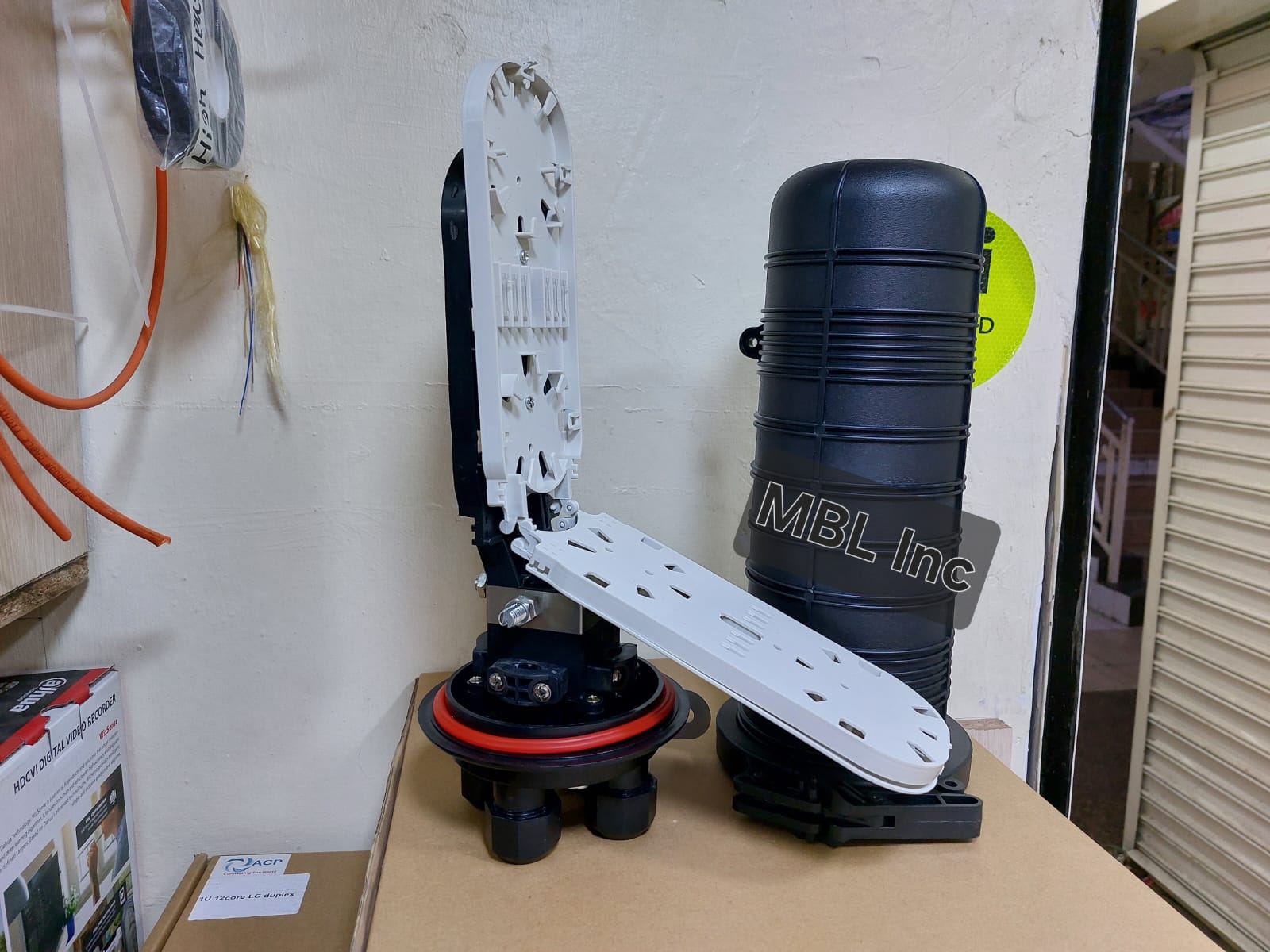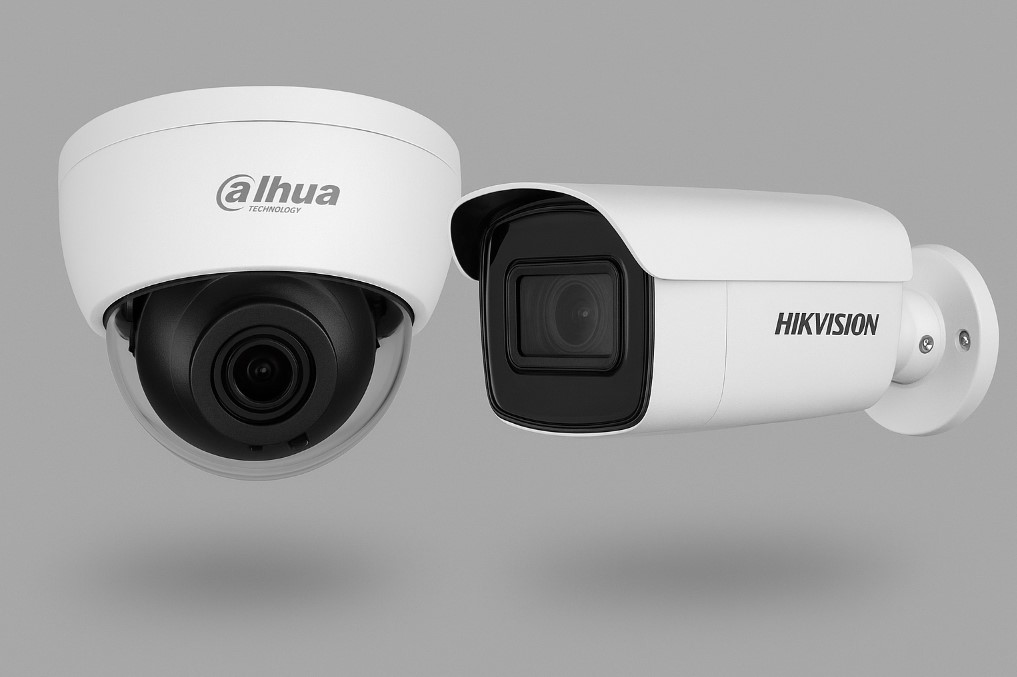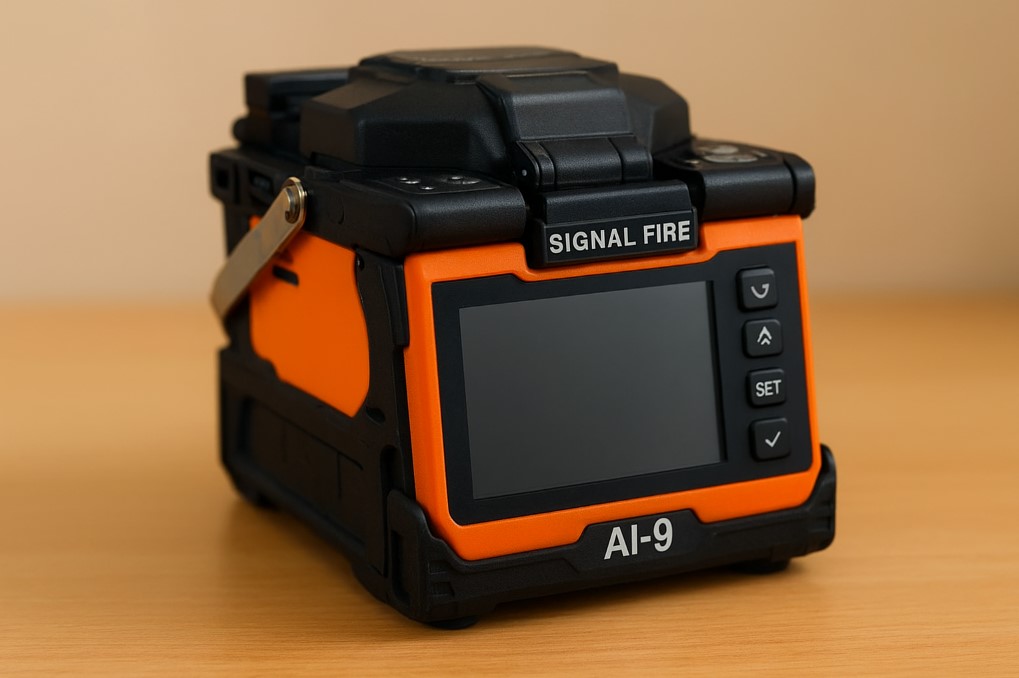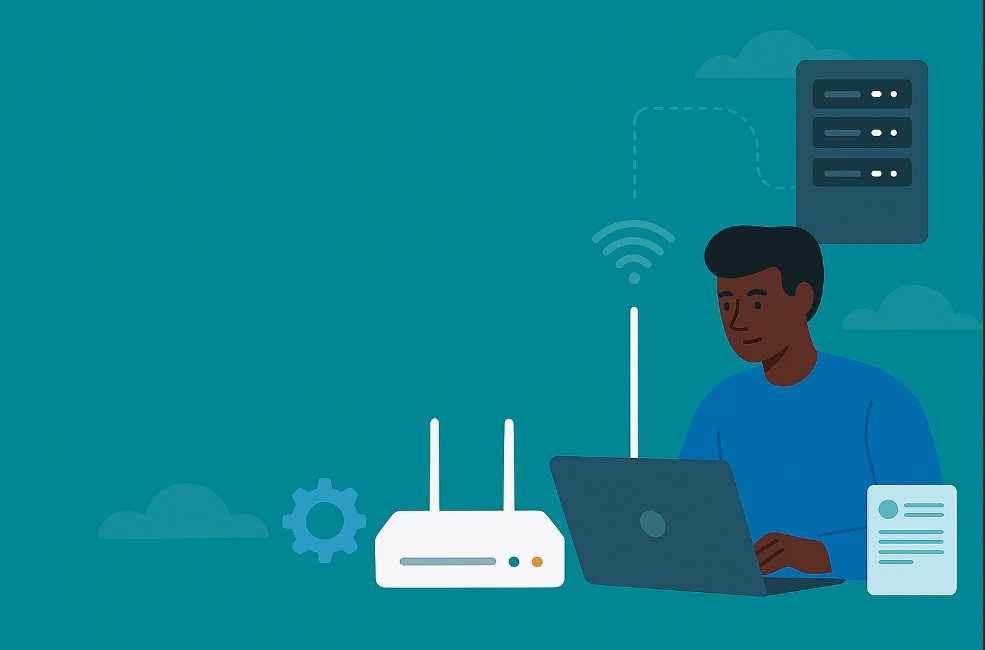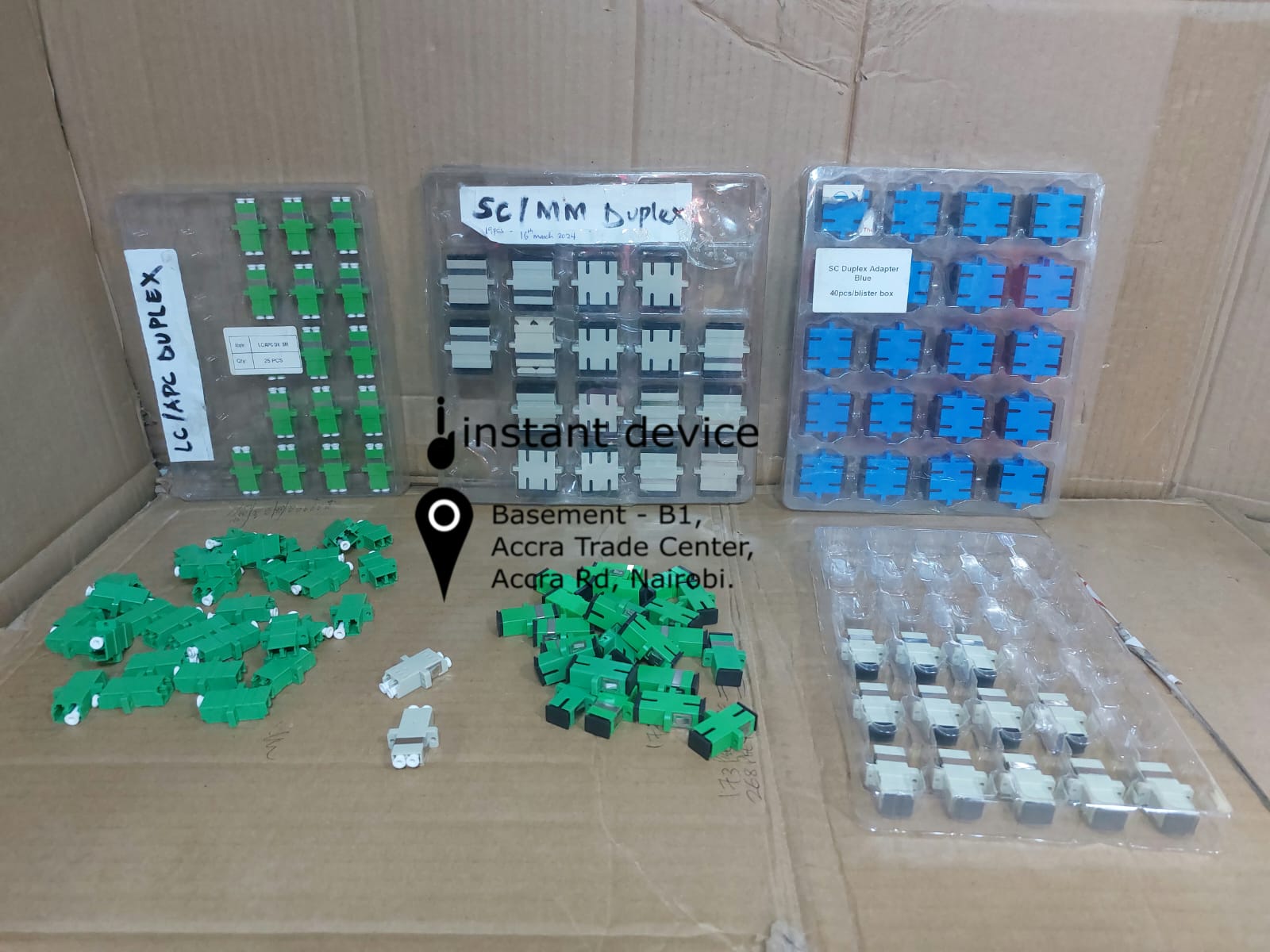Blog
Why CCTV is The Hottest Product In Kenya Today
In Nairobi right now, you’ll likely see a massive billboard or shop signs advertising Chinese surveillance brands on almost every street.
Dahua, HikVision, and other camera systems dominate the city skyline just as much as real estate cranes.
What you may not know is that this CCTV boom was created by the Chinese themselves.
Back in January 2017, while still working as a journalist, I visited Twyford Tiles, a newly established Chinese tile manufacturer in Kajiado, just off Namanga Road. The factory had launched the previous December, and I was tasked with exploring how it hoped to impact Kenya’s construction industry.
The visit, however, revealed something bigger than tiles.
It showcased a management culture that has since become one of the strongest drivers of the surveillance equipment market in Kenya.
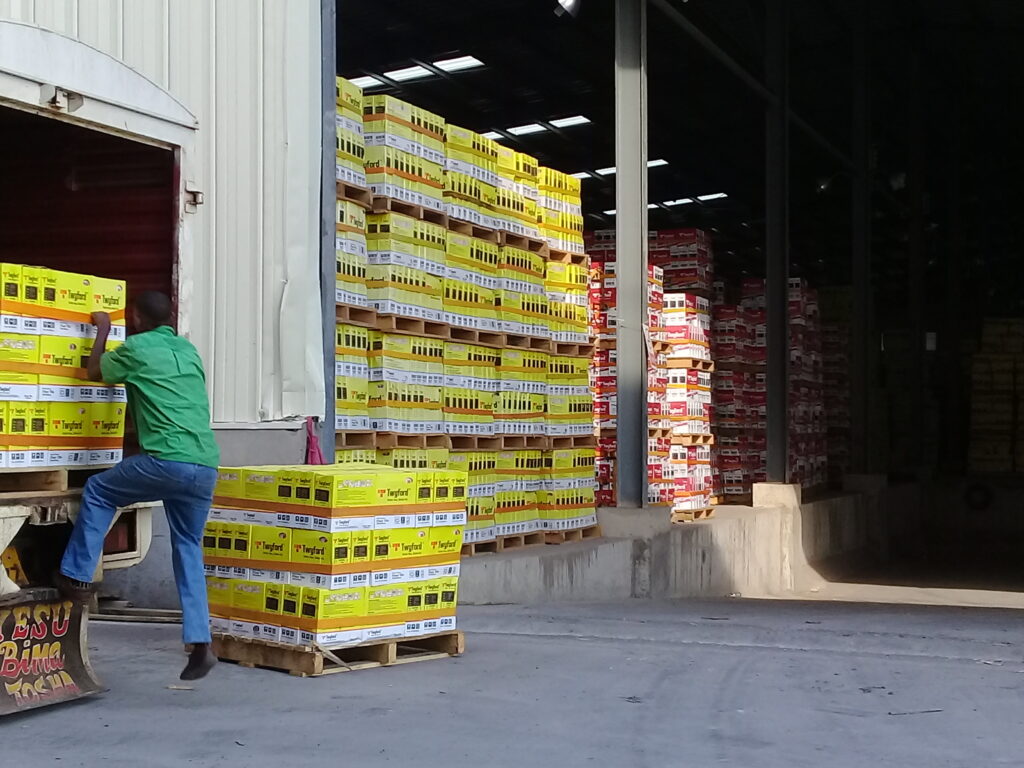
Chinese Companies and the CCTV Culture
Inside the factory, I noticed two things immediately:
- Language barriers with locals.
Many Chinese managers struggled to communicate and often avoided direct engagement. - Heavy reliance on CCTV systems.
Surveillance cameras were everywhere, backed by large control rooms. Instead of relying on Kenyan foremen or lengthy confrontation, Chinese project managers in Kenya used CCTV to monitor, discipline, and even replace workers.
Misconduct, whether it was theft, ignoring safety rules, or unauthorized breaks, was swiftly handled through video evidence.
No debates, no appeals.
Outside the gate, young Maasai morans waited to see if layoffs had opened new opportunities.
It became clear, in Chinese-run projects, CCTV was the silent supervisor that shaped labor turnover.
Surveillance Demand in Chinese Construction Projects
Over the years, the Chinese footprint in Kenya has grown from highways to skyscrapers, from government-funded infrastructure to private real estate.
Today, Nairobi’s morning matatus heading to Kilimani, Kileleshwa, and Westlands are packed with mjengo guys reporting to Chinese-funded sites.
For context, the story of Twyford Tiles in Kajiado is not just a personal observation but part of a broader narrative that has attracted international coverage.
Outlets such as Caixin Global have documented how Chinese companies like Twyford have expanded into Africa, shaping industries from construction materials to large-scale infrastructure.
Linking these developments to the surveillance culture on project sites shows just how intertwined Chinese investment and local market opportunities have become in Kenya.
But while the scale of these projects has provided thousands of jobs, managing large local workforces has remained a headache for Chinese managers who neither trust Kenyan foremen nor prefer direct confrontation.
The solution? Surveillance cameras, everywhere.
- Construction sites and factories now feature extensive CCTV systems.
- Control rooms have become standard in new installations.
- Investors overseas demand live video streams to verify progress and protect billion-shilling projects.
This approach has directly created a booming market for surveillance products in Kenya, especially among suppliers who understand the unique needs of Chinese clients.
Instant Device: Trusted Supplier of CCTV in Kenya
At Instant Device, we have positioned ourselves at the heart of this market by supplying Dahua and HikVision products in Kenya, two of the world’s most trusted CCTV brands and favorites of Chinese clients.
But our work goes beyond sales:
- Surveillance Consultation & Troubleshooting
We help identify loopholes such as blind spots and camera tampering, ensuring full coverage on construction sites. - After-Sales Service & Repairs
Construction environments are tough on equipment. We coordinate repairs and maintenance with Dahua and HikVision service centers, keeping systems running without interruption. - Adaptability to Market Needs
By understanding how Chinese contractors in Kenya operate, we deliver solutions tailored to their strict oversight and investor reporting requirements.
Conclusion
From a factory in Kajiado to the skyscrapers shaping Nairobi’s skyline, Chinese companies in Kenya have brought with them a management style deeply rooted in surveillance.
This has fueled a steady demand for CCTV systems, making surveillance suppliers in Kenya an essential part of the construction ecosystem.
At Instant Device, we remain committed to meeting this demand by providing Dahua Kenya and HikVision Kenya solutions, backed with expert support and reliable after-sales service.
For Kenyan suppliers, this isn’t just business, it’s a long-term market created at the intersection of global investment, local labor, and the quiet authority of surveillance cameras.
Chinese Brands and the Challenge of Confusion: The Signal Fire Story
Chinese are the OGs of brand confusion, and it’s not always easy to know what to call most of their products.
This stems from a long-held government policy that prioritized resource deployment into core product R&D and mass production, while marketing and brand identity were left as an afterthought.
The result has been an influx of highly specialized equipment that often arrives in new markets with unclear branding, inconsistent naming, and little to no usage documentation.
For dealers, resellers, and end-users alike, this creates significant challenges.
Operating, maintaining, and even identifying the right equipment becomes complicated, often leading to safety risks, troubleshooting headaches, and parts replacement issues.
In growth markets like Kenya, where emerging tech-driven sectors depend heavily on Chinese gear to scale, the problem is even more pronounced.
Dealers and ISPs shoulder most of the burden, while end-users face longer learning curves just to get the technology working reliably.
This has been a recurring reality in the internet infrastructure sector, which relies almost entirely on Chinese hardware to deploy and expand fiber connectivity.
Yet amidst this backdrop of confusion, one product’s story stands out.
👉 Today, the Signal Fire AI9 Fusion Splicer is a trusted name in Kenya’s fiber industry.
But just a few years ago, it was a mysterious “orange splicing machine” clouded by doubts, high costs, and misinformation.
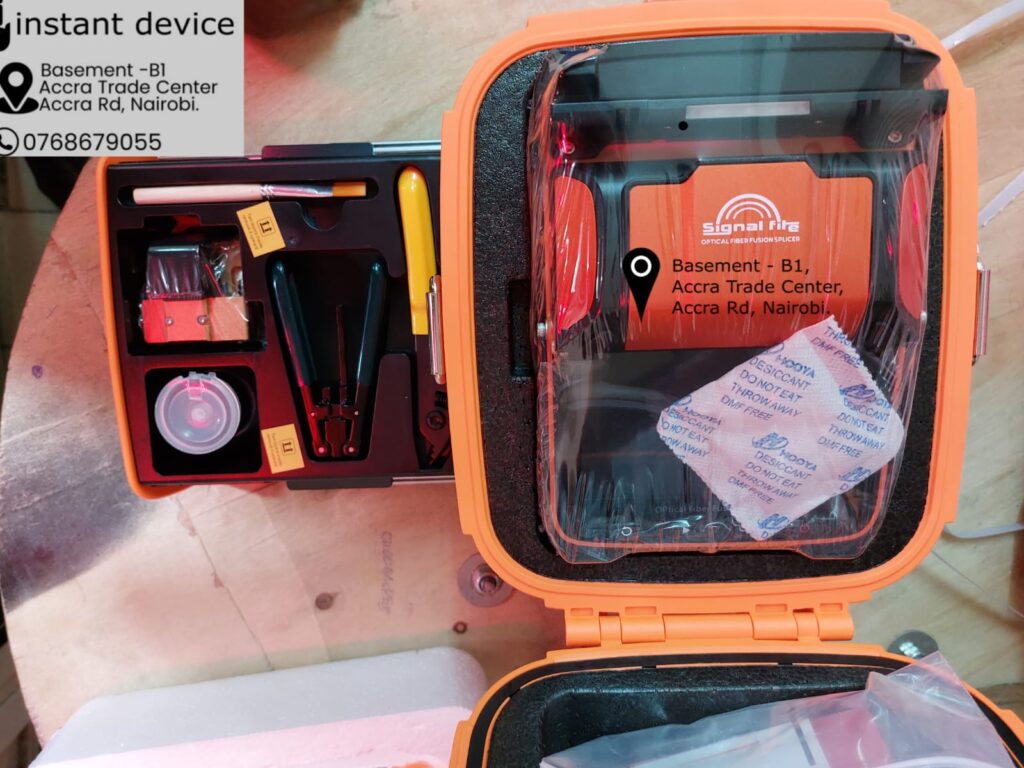
This is the story of how Instant Device helped change perceptions, connected ISPs with trusted technicians, and built confidence in the brand, turning Signal Fire into a household name in Kenya’s fiber optics industry.
The Era of Doubts and Hires
- Back in 2021, most ISPs in Kenya were hesitant to buy fusion splicers. Instead, they hired technicians who had invested in the AI9.
- A single fiber core splice was going for KES 1,000 – 1,500 in 2021. When you do the math, a pair of electrodes (good for about 5,000 splices) meant a technician could generate KES 5 million to 7.5 million from one pair of splice electrodes.
- Many ISPs assumed the machine was obsolete after 5,000 splices, not knowing electrodes could be replaced affordably, for as little as KES 7,500 in 2021 and 2022.
- At this time, the machine was selling for around KES 150,000, and for many ISPs just getting started with fiber-to-the-home (FTTH) rollouts, this was seen as a risky investment.
👉Instead of buying, most ISPs chose to hire splicing services from technicians who had positioned themselves to own and lease out the AI9.
But as you have seen above, hiring wasn’t cheap.
The high cost of outsourcing made fiber projects expensive and unsustainable for smaller ISPs.
2022 – The Confusion of Names
People didn’t know what to call the AI9. It was “A9,” “Signal something,” or simply “the orange machine with the box showing a man on a stool.”
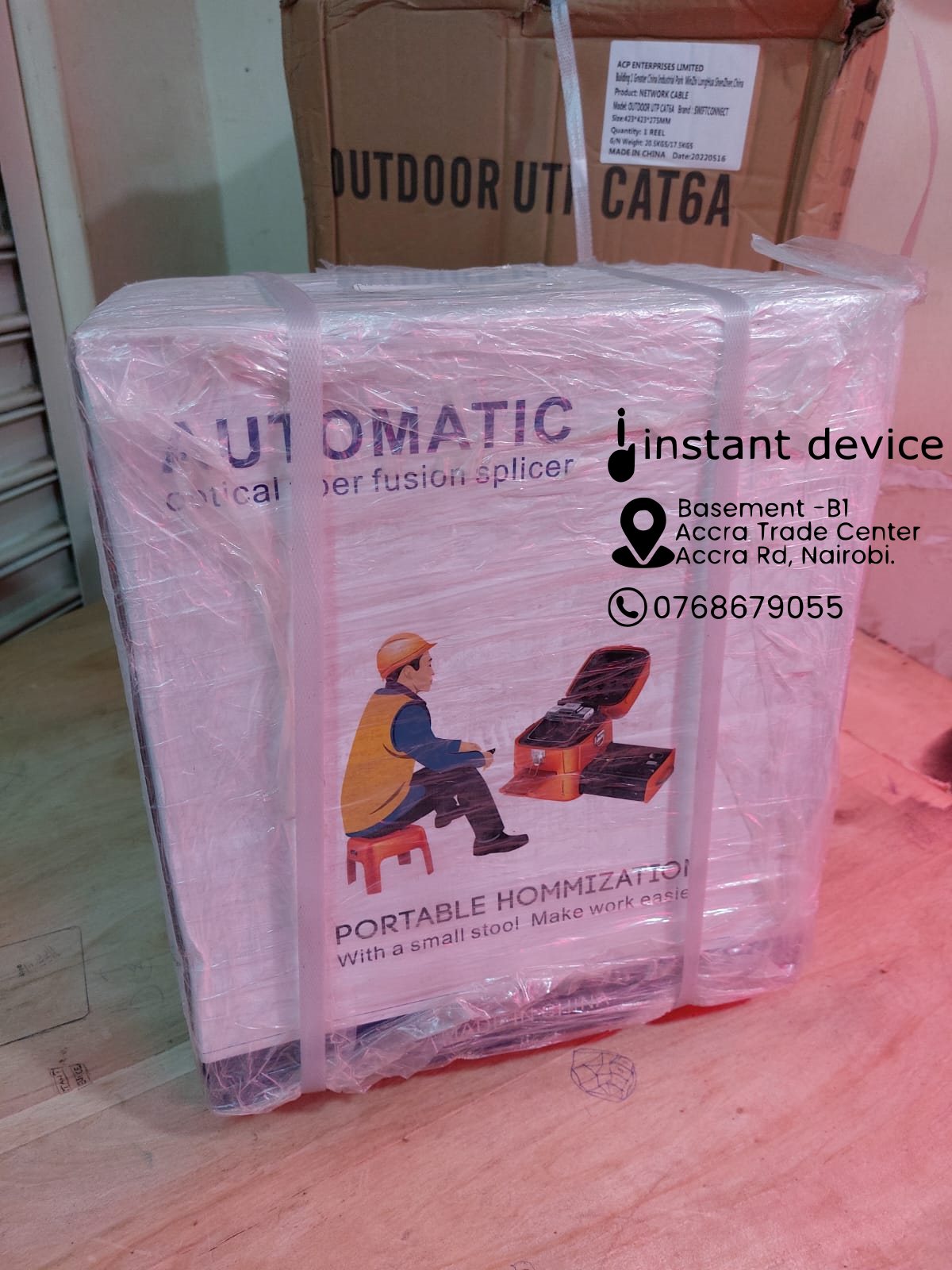
This was the year when much of the confusion was addressed.
At Instant Device, we decided to standardize the name: Signal Fire: Model AI9 Fusion Splicer
Our Jiji adverts, product listings, and customer support consistently used this naming, and soon, ISPs began asking for “Signal Fire” instead of “that orange machine.”
💡 Fun Fact: Instant Device was at the forefront of popularizing the name “Signal Fire” in Kenya.
Clearing Gray Areas and Building Trust Through Support
Beyond the Signal Fire brand confusion and skepticism, we tackled one of the biggest hurdles ISPs faced after buying the splicer.
That was servicing and repair.
Nairobi had and still has only one company that can service the AI9 properly, and finding them was a real hassle.
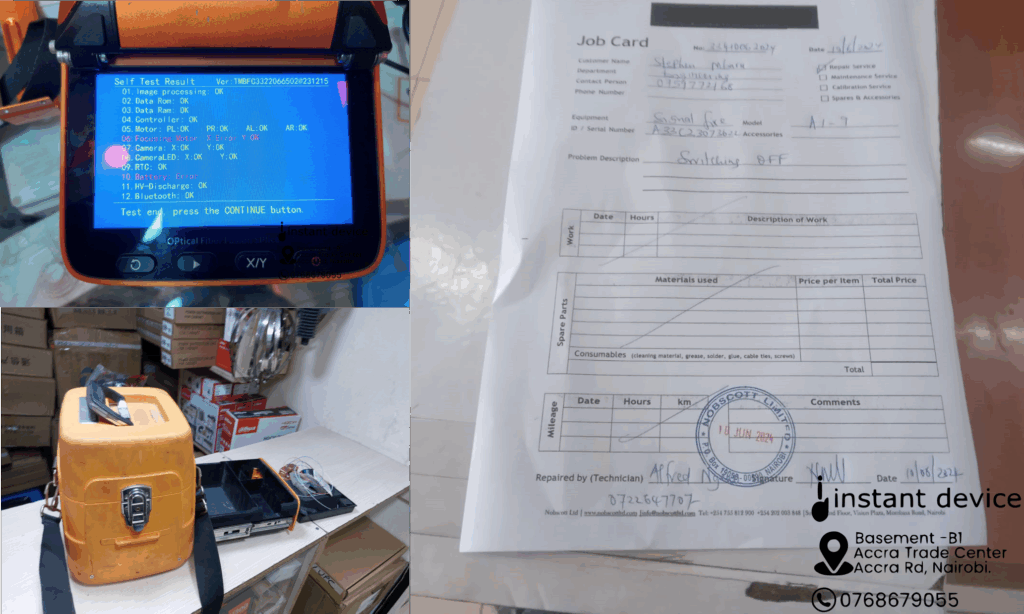
We also introduced a unique troubleshooting loop that involved comparing what User A reported with what Users B & C experienced, then relaying the findings back into the ISP community WhatsApp Groups.
Most of the solutions came from working closely with technicians who were not just owners but daily users of the AI9, which made the troubleshooting practical and effective.
👉 This open, community-driven support network helped resolve issues faster and made customers feel more secure about ownership.
Breaking the Electrode Myth
One of the turning points was dispelling the myth of obsolescence.
By proving that electrodes could be replaced affordably, at KES 7,500 in 2022, we erased the fear that the AI9 was a “use-and-throw” machine.
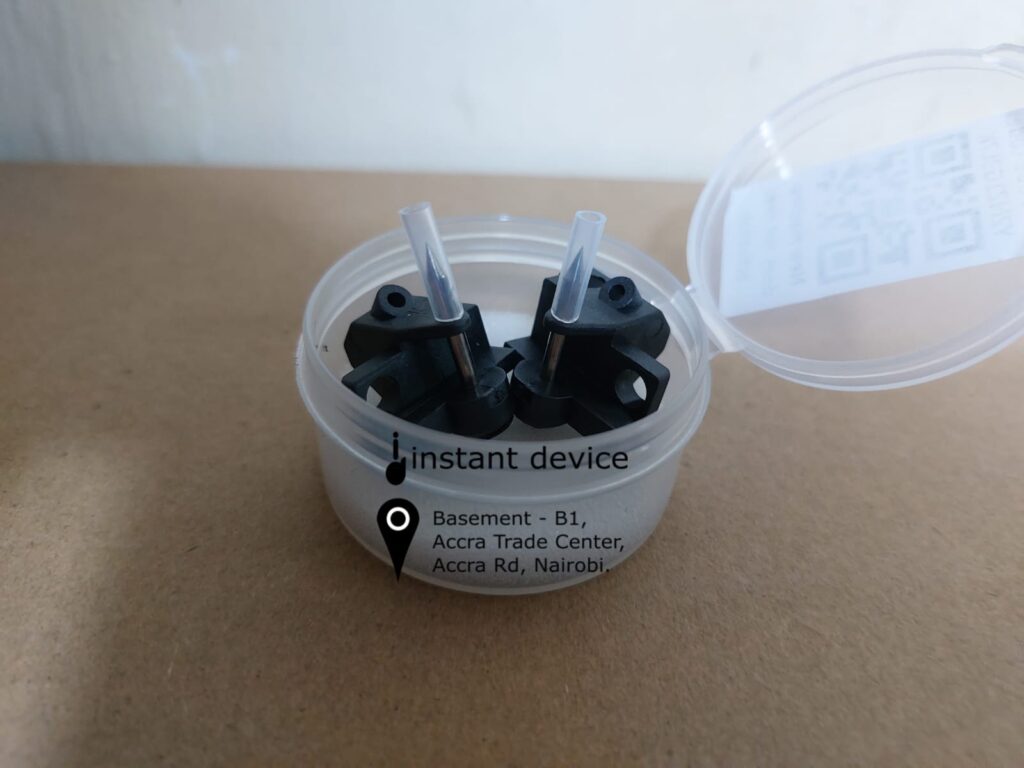
Signal Fire Fusion Splicer Electrodes
Sharing this information in local ISP WhatsApp groups was a game changer.
This single fact, backed by Instant Device stocking replacement electrodes, helped convert skeptics into believers.
Many ISPs started warming up to the idea that owning the AI9 was not just possible, but also sustainable.
From Skepticism to Ownership
Fast-forward from 2023 to today, and the AI9 has gone from a hired tool to an owned asset.
Most ISPs now prefer to buy and keep their own machine, cutting costs and achieving much-needed economies of scale in FTTH deployments.
The numbers speak volumes:
- 2021: Price at KES 150,000 – limited adoption, heavy reliance on hiring.
- 2023: Price eased to KES 130,000 – gradual trust-building phase.
- 2024 – 2025: Price now at KES 85,000 – thanks to rising demand and consistent supply from multiple resellers, making ownership accessible to the smallest ISPs.
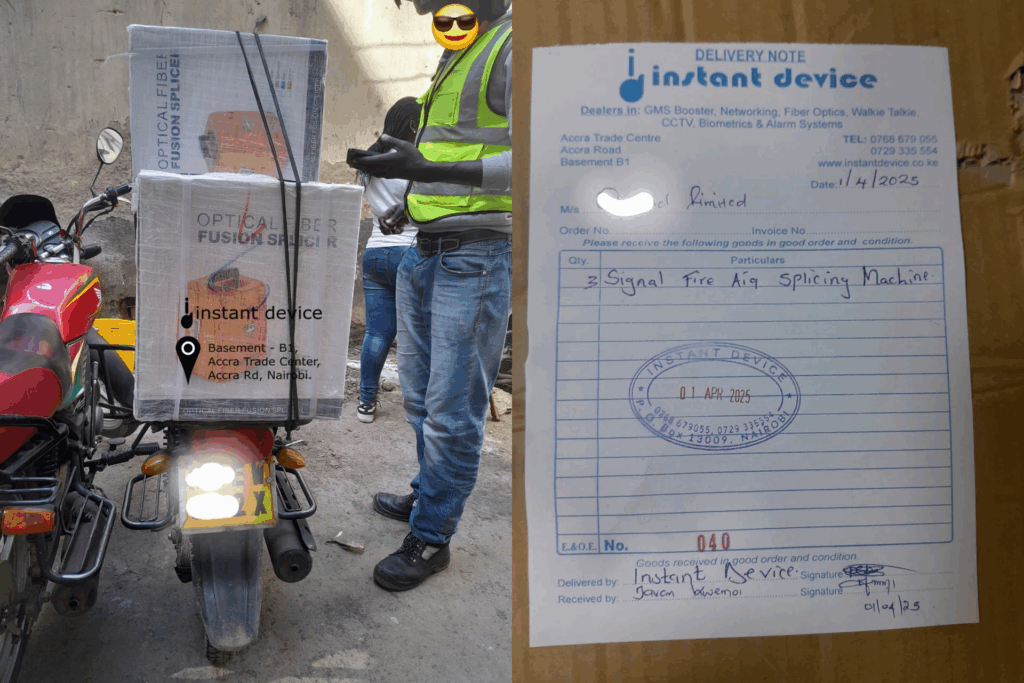
This price evolution, combined with increased market knowledge and availability of spare parts, has made the AI9 one of the most trusted, cost-effective, and widely adopted fusion splicers in Kenya.
Today, Signal Fire is one of the most trusted splicing machines in Kenya, and Instant Device remains a genuine dealer providing not just sales, but also after-sales support, spares, and trusted connections to technicians.
The Bigger Lesson
The journey of the Signal Fire AI9 Fusion Splicer in Kenya shows the power of reliable information, after-sales support, and community-driven learning.
From being “that orange splicer” in 2021 to a trusted ISP workhorse today, its adoption is a story of resilience, collaboration, and trust.
Today, thanks to affordability and better technical support, owning an AI9 is no longer a gamble, but a strategic move that helps ISPs survive and thrive.
And at the center of that story is Instant Device, the genuine dealer that made owning a Signal Fire AI9 not just possible, but practical.
📲 Ready to invest in your own Signal Fire AI9?
Buy now at InstantDevice.co.ke or Call/WhatsApp 0768 679 055 for delivery and support across Kenya.
How To Supercharge Your ISP Business with SFPs
In the fast-paced world of telecommunications, Internet Service Providers (ISPs) in Kenya and East Africa face mounting pressures to deliver reliable, scalable, and cost-effective connectivity.
With rising demand for broadband, mobile backhaul, and enterprise services amid rapid urbanization and digital transformation, ISPs must innovate to stay ahead.
Interestingly, the financial services sector, known for its mission-critical networks, offers a blueprint for success.
By adopting strategies centered around Small Form-factor Pluggable (SFP) transceivers, such as the Avago AFCT-5715APZ-NS1, ISPs can mirror the efficiency of banks and financial institutions.
This 1310nm, 1.25Gbps transceiver designed for up to 10km over single-mode fiber (SMF) exemplifies modular, high-performance optics that can transform ISP infrastructures.
The Avago AFCT-5715APZ-NS1 is mentioned here for a case-scenario breakdown. Most MSA (Multi-Source Agreement)-compliant SFP modules will work in the setup described below.
These include:
- Dell EMC FTLF1318P3BTL-FC
- Huawei RTXM191-502 (1.25G-1550nm-80km-SM-ESFP)
- Mikrotik S-31DLC20D (1.25G DDM SFP 20KM 1310nm)
- Huawei RTXM191-450 (1.25G-1310nm-40km-SM-ESFP)
- Huawei MXPD-243S (1.25G-1310nm-10km-SM-ESFP)
- Sopto SPT-P131G-10D (1.25G 1310nm 10km DDM)
Drawing parallels from how financial providers use SFPs to interconnect core systems and ensure seamless operations, this article explores seven key strategies ISPs can implement.
From scalable backbones to proactive maintenance, these approaches promise enhanced reliability, reduced costs, and better service delivery in regions like Nairobi, Kampala, and Dar es Salaam.
1. Building a Scalable Fiber Backbone Infrastructure
Avago modules, being Multi-Source Agreement (MSA)-compliant, work seamlessly with gear from vendors like Cisco, Mikrotik, Ubiquiti, Huawei, TP-Link and D-Link.
This interoperability lets ISPs standardize on cost-effective SFPs while mixing equipment from different suppliers, avoiding vendor lock-in.
For Kenyan and East African providers, often operating on tight budgets, this reduces capital expenditures (CAPEX) and fosters flexibility in procurement.
It’s a practical way to build hybrid networks that evolve with technology trends without breaking the bank.
2. Achieving Efficient Metro and Regional Connectivity
In financial backends, SFPs enable low-latency data replication between headquarters and DR sites, critical for real-time transactions.
ISPs can replicate this by using long-range SFPs (ranging from 10km to 80km) to connect metro rings and regional networks.
For instance, bridging urban hubs like Nairobi to rural areas in Kenya or extending to neighboring countries in East Africa reduces dependence on costly third-party leased lines.
By gaining direct control over bandwidth, ISPs can optimize latency for services like video streaming or cloud access, ultimately slashing operating expenses.
In a region where infrastructure gaps persist, this strategy empowers local providers to build resilient, self-reliant networks.
3. Ensuring Redundancy and High Availability
Banks prioritize uptime for mission-critical data, often using redundant SFP uplinks to safeguard against failures.
ISPs should follow suit by implementing dual-homed SFP fiber uplinks in access and aggregation switches.
If one link goes down, due to fiber cuts from construction or natural disruptions common in East Africa, traffic automatically reroutes, maintaining seamless service.
This setup helps ISPs meet stringent 99.9% uptime Service Level Agreements (SLAs), crucial for retaining enterprise clients and residential subscribers.
In competitive markets like Kenya’s, where outages can lead to customer churn, such redundancy translates to a significant edge.
4. Optimizing Service Segmentation with CWDM/DWDM SFPs
Financial setups segment applications, like ATMs, core banking, and mobile money, across separate wavelengths for efficient multiplexing.
ISPs can harness Coarse Wavelength Division Multiplexing (CWDM) or Dense WDM (DWDM) SFP modules to do the same, carrying multiple services over a single fiber pair.
Imagine residential broadband, enterprise VPNs, and mobile backhaul coexisting without interference, maximizing the return on infrastructure investment.
For East African ISPs grappling with limited fiber resources, this means squeezing more value from existing deployments, supporting diverse needs from urban fintech hubs to remote agricultural IoT applications.
5. Streamlining Customer Premises Interconnects
Financial engineers often use Bidirectional (BiDi) SFPs for single-fiber efficiency in branch connections.
ISPs can adopt BiDi SFPs at customer premises or branch POPs (Point of Presence) to conserve fiber pairs, particularly in Fiber-to-the-Home (FTTH) or Fiber-to-the-Building (FTTB) rollouts.
In dense urban areas like Nairobi, where fiber scarcity is a real challenge, this reduces deployment costs and simplifies installations.
By minimizing the need for additional cabling, ISPs can accelerate last-mile connectivity, bringing high-speed internet to more households and businesses across Kenya and East Africa.
6. Enabling Diagnostics and Proactive Maintenance
Digital Diagnostics Monitoring (DDM) or Digital Optical Monitoring (DOM) in SFPs allows financial services to track metrics like temperature, power levels, and link health in real time.
ISPs can leverage these features to monitor their networks proactively, spotting issues like fiber degradation before they cause outages.
In East Africa’s variable climates, from humid coastal regions to arid interiors, this capability prevents costly disruptions.
By shifting from reactive to predictive maintenance, ISPs enhance overall network longevity and customer satisfaction, aligning with the reliability standards of global financial networks.
7. Driving Cost-Efficiency Through Interoperability
Avago modules, being Multi-Source Agreement (MSA)-compliant, work seamlessly with gear from vendors like Cisco, Mikrotik, Ubiquiti, Huawei, TP-Link, D-Link and Aruba.
This interoperability lets ISPs standardize on cost-effective SFPs while mixing equipment from different suppliers, avoiding vendor lock-in.
For Kenyan and East African providers, often operating on tight budgets, this reduces capital expenditures (CAPEX) and fosters flexibility in procurement.
It’s a practical way to build hybrid networks that evolve with technology trends without breaking the bank.
💡 If SFPs form the backbone of scalable ISP networks, then ONT management is the brain that keeps operations lean and customer experiences seamless. Learn more in our next article: Why Remote ONT Management is the Secret Weapon of Growth-Focused ISPs.
And once you see the power of remote ONT control, check out a real-world success story: How Safaricom Leveraged Huawei & Nokia to Dominate Kenya’s Fiber Market.
In Summary: A Path to Reliable, Scalable Networks
By emulating financial institutions, ISPs in Kenya and East Africa can achieve remarkable network efficiency.
Key takeaways include:
- Constructing modular backbones with SFP uplinks.
- Utilizing long-range modules for metro and regional coverage
- Incorporating redundancy and CWDM/DWDM for service segmentation.
- Deploying BiDi modules for economical FTTH/FTTB. And,
- Employing DDM/DOM for proactive maintenance.
This strategy delivers the same levels of reliability, scalability, and cost control that financial providers depend on, but tailored to broadband, mobile backhaul, and enterprise services.
As the region continues its digital leap, fueled by initiatives like Kenya’s Digital Economy Blueprint and Microsoft’s Airband Initiative, adopting these SFP-centric approaches isn’t just an option; it’s a necessity for sustainable growth.
ISPs ready to invest in such innovations will not only meet today’s demands but thrive in tomorrow’s connected landscape.
What are your thoughts on integrating SFPs into ISP networks? Share in the comments below!
How Safaricom Leveraged Huawei & Nokia to Dominate Kenya’s Fiber Market
If you read our last piece on why remote ONT management is the secret weapon of growth-focused ISPs, you’ll see exactly why Safaricom’s vendor strategy has been so effective. This article takes that conversation forward.
Safaricom’s rise as Kenya’s fiber market leader isn’t just about laying down kilometers of optical cable.
It’s about how they partnered with the right technology vendors to scale faster, simplify operations, and deliver consistent customer experiences.
At the core of this success story is a strategic use of Huawei and Nokia solutions, each serving different but complementary roles in Safaricom’s fiber-to-the-home (FTTH) and broadband roadmap.
Huawei: The Accelerator of Fiber Rollout
Back in 2017, Safaricom selected Huawei’s FTTH solution to speed up deployment.
Huawei offered an end-to-end ecosystem, Optical Line Terminals (OLTs), Optical Network Terminals (ONUs/ONTs), fiber access equipment, and the integration layer.
This approach enabled Safaricom to:
- Cut time-to-market by reducing integration headaches
- Standardize customer equipment with Huawei ONTs that could be remotely managed via OMCI
- Scale customer acquisition rapidly in high-demand areas
Huawei’s turnkey package was about speed, and that was critical during Safaricom’s aggressive expansion phase.
👉 Discover the unsung hero of ISP networks in our next deep dive: How To Supercharge Your ISP Business with SFPs.
Nokia: Efficiency, Flexibility, and the Long Game
But Safaricom didn’t just bet on one vendor.
Nokia came in to complement Huawei, bringing in expertise around:
- GPON/FTTx access optimization
- Energy-efficient networks to cut operational costs
- Fixed Wireless Access (FWA) solutions to extend broadband where fiber civil works were too slow or expensive
This dual-vendor strategy gave Safaricom flexibility. Huawei’s ONTs and rollout gear got fiber to the ground fast, while Nokia’s solutions optimized network operations and explored alternative broadband models.
Backbone Capacity: Preparing for Demand
As customer numbers grew, Safaricom reinforced its backbone with 400G transport networks, again partnering with Huawei.
This ensured the fiber access network had enough muscle behind it to handle exploding broadband traffic, especially as video streaming, gaming, and cloud services surged.
Why Vendor Strategy = Customer Retention
So, how does all this tie back to customer retention, the true battleground for ISPs?
- Remote ONT management: Vendor-supplied ONUs/ONTs that integrate smoothly with OSS/BSS systems mean fewer truck rolls, faster issue resolution, and smoother billing/activation.
- Operational diversity: By mixing Huawei and Nokia, Safaricom avoided vendor lock-in while leveraging the best of each world.
- Future-readiness: FWA and energy-optimized solutions mean Safaricom can serve customers beyond traditional fiber footprints without compromising quality.
The outcome is clear, Safaricom keeps churn low by solving customer problems before they become complaints, and that’s exactly how you hold market leadership.
👉 Want to understand why remote ONT management is the foundation of this success? Read our deep-dive on Why Remote ONT Management is the Secret Weapon of Growth-Focused ISPs.
Why Remote ONT Management is Your Secret Growth Weapon
Ever wondered how the big ISPs always seem to have their act together when it comes to client retention?
I was given an eye-opener early in 2024 by Hans Haerdtle, former Liquid Telecom CEO and now one of the program managers at Liquid Labs Kenya.
Here’s the thing, many low-and medium-tier ISPs struggle to scale, while top-tier ISPs thrive with tens of thousands, or even hundreds of thousands, of subscribers.
Why?
The secret lies in how they manage customer equipment and service issues.
Let’s face it, no one is immune to network downtime.
Sometimes a customer forgets their WiFi password. Other times, they want to kick out a rogue neighbor who’s piggybacking on their WiFi.
Then there are billing issues, say a client misses a payment, gets disconnected, and calls back furious when their WiFi doesn’t reconnect after clearing the bill.
If you don’t have the right systems in place, each of these problems forces you to dispatch a support team onsite.
That quickly becomes unmanageable, and expensive, when you start growing beyond a few hundred clients.
Hans introduced me to the concept of Operations Support Systems (OSS), which underpin how top-tier ISPs, like Safaricom, keep operations smooth.
Remote management of ONTs, the customer-premise devices that terminate fiber connections, is a critical part of this.
Without it, your ISP will always struggle with high costs, slow service recovery, and eventual customer churn.
👉 Curious how these principles play out in the real world? See how Safaricom has leveraged Huawei and Nokia ONUs to scale fast, streamline operations, and tighten its grip on Kenya’s fiber market. Read the full story here: How Safaricom Leveraged Huawei & Nokia to Dominate Kenya’s Fiber Market.
How ONTs Are Normally Managed
In a GPON/XPON network, the ISP’s OLT (Optical Line Terminal) manages ONTs (Optical Network Terminals) remotely.
This is done using a protocol called OMCI (ONU Management and Control Interface).
Through OMCI, the OLT can:
- Configure the ONT (WAN settings, VLANs, QoS, etc.)
- Monitor performance in real-time
- Push firmware and security updates
All without sending a technician onsite.
Vendor Implementation Differences
Now, here’s the catch. Even though OMCI is standardized (ITU-T G.988), different vendors like Huawei, ZTE, TP-Link, or Tenda often add their own extensions or interpret the standard differently.
For OMCI to work smoothly, the OLT needs a profile or template tailored to each ONT model.
That template basically tells the OLT, “Here’s how to talk to this ONT.”
When Vendor Support Is Limited: My Tenda HG6 Experience
Toward the end of 2023, I imported a consignment of Tenda HG6 N300 WiFi XPON ONTs, which were becoming popular among Kenyan ISPs. I hoped they’d be suitable for a proof of concept (PoC) Liquid Labs was running under Microsoft’s Airband Initiative.
Hans put them to the test, but hit a wall.
The problem?
Tenda does not publish the OMCI details for the HG6.
That meant Hans couldn’t build a reliable OMCI management profile for it.
Without that template, the ONT couldn’t be remotely provisioned or managed by the OLT.
Configuration could only be done manually through the web interface or CLI, a dealbreaker for any ISP trying to scale.
Common Workarounds ISPs Use
So, what happens when OMCI support is limited or unavailable? Top ISPs don’t just give up, they adapt.
Here are the common workarounds:
- Use TR-069 with an ACS (Auto-Configuration Server)
- Some ONTs support TR-069 (also known as CWMP), which allows remote management over the internet instead of OMCI.
- This is great for things like WiFi SSIDs, passwords, and firmware updates.
- The limitation? It doesn’t always handle deeper GPON parameters like VLAN or GEM port settings.
- Some ONTs support TR-069 (also known as CWMP), which allows remote management over the internet instead of OMCI.
- Run the ONT in Bridge Mode + External Router
- The ONT is used purely as a GPON-to-Ethernet bridge.
- All routing, WiFi, firewall, and QoS features are handled by an external router that the ISP can fully manage.
- This way, the ONT only needs to authenticate with the OLT, and the ISP keeps control through the router.
- The ONT is used purely as a GPON-to-Ethernet bridge.
- Leverage Generic OMCI Profiles
- Some OLTs ship with default OMCI profiles that can talk to most ONTs at a basic level.
- With trial-and-error, ISPs can sometimes make ONTs work for internet services, but advanced features like IPTV or VoIP may not be supported.
- Some OLTs ship with default OMCI profiles that can talk to most ONTs at a basic level.
- Simplify the Service Offering
- Some ISPs choose to limit unsupported ONTs to internet-only services.
- This avoids the complexity of provisioning multiple service layers (like IPTV and VoIP) that need deeper OMCI integration.
- Some ISPs choose to limit unsupported ONTs to internet-only services.
- Stick With Vendor-Aligned Ecosystems
- Finally, many ISPs simply avoid brands that don’t publish OMCI details and standardize on vendors like Huawei, ZTE, or Nokia.
- The initial cost may be higher, but it saves massively in operational headaches down the line.
- Finally, many ISPs simply avoid brands that don’t publish OMCI details and standardize on vendors like Huawei, ZTE, or Nokia.
The Big Picture
The lesson from Hans was clear that remote ONT management isn’t optional, it’s the backbone of any growth-focused ISP.
Without it, costs balloon, customer experience suffers, and churn becomes inevitable.
If you’re an ISP planning to scale, factor in OSS and ONT remote management from day one.
Otherwise, you’ll always be stuck playing catch-up against the bigger players.
👉 Discover the unsung hero of ISP networks in our next deep dive: How To Supercharge Your ISP Business with SFPs.
Everything You Need to Know About FTP CAT 6 Outdoor LAN Cables
In today’s fast-paced digital world, having a reliable and high-performance network connection is more important than ever. Whether you’re setting up an outdoor security system, expanding your business network, or enhancing your home’s internet connectivity, the FTP CAT 6 Outdoor LAN Cable is a game-changer.
Engineered to deliver exceptional speed, durability, and stability, this cable is designed to thrive in challenging outdoor environments. With advanced shielding to combat interference and a robust jacket to withstand harsh weather, it’s the ultimate solution for seamless, high-speed networking.
But what makes FTP CAT 6 Outdoor LAN Cables stand out? In this blog, we’ll dive into their features, benefits, and why they’re the perfect choice for your outdoor networking needs. Let’s unravel the technology that keeps you connected, no matter the conditions!
The Ideal Choice for Outdoor Networking in East Africa
As East Africa continues to embrace the digital revolution, reliable outdoor networking solutions are becoming essential for businesses, homes, and institutions. The FTP CAT 6 Outdoor LAN Cable stands out as a top choice, offering exceptional performance tailored for the region’s unique demands.
Ready to elevate your outdoor networking experience? Choose a reliable, high-speed FTP CAT 6 Outdoor LAN Cable for unbeatable performance in any environment. Check our online store for the best deals or visit our physical shop in Nairobi for the most affordable prices and expert advice.
The store is located on Accra Trade Center, Accra Rd. Find us in the Basement, Shop B1.
Key Features of FTP CAT 6 Outdoor LAN Cable
- High-Speed Performance:
- Supports up to 1 Gbps data transfer speeds for efficient and reliable networking.
- Bandwidth capacity of up to 250 MHz for smooth performance in high-demand applications.
- Foiled Twisted Pair (FTP) Shielding:
- Reduces electromagnetic interference (EMI) and crosstalk for a stable connection.
- Weather-Resistant Jacket:
- Constructed with UV-resistant and water-resistant materials to endure harsh sunlight, heavy rains, and fluctuating temperatures.
- Ideal for outdoor environments across East Africa.
- Durability and Longevity:
- Tough PE or PVC outer coating that resists physical damage, wear, and tear.
- Pure Copper or CCA Options:
- Available in pure copper for premium conductivity or cost-effective Copper-Clad Aluminum (CCA).
Benefits of Using FTP CAT 6 Outdoor LAN Cable
- Dependable Outdoor Networking:
- Perfect for connecting surveillance systems, outdoor access points, and distant devices in campuses or industrial setups.
- Resistant to Harsh Conditions:
- Withstands East Africa’s diverse climate, from coastal humidity to dry, sun-baked regions.
- Enhanced Signal Integrity:
- Minimizes signal loss and interference, ensuring stable connections even in areas with high electromagnetic activity.
- Cost-Effective Solution:
- Reduces long-term maintenance costs due to its durability and reliable performance.
- Eco-Friendly Options:
- RoHS-compliant cables are safe for both users and the environment.
Why It’s Perfect for East Africa’s Networking Needs
East Africa’s expanding infrastructure requires robust networking solutions, and the FTP CAT 6 Outdoor LAN Cable fits the bill. Its ability to withstand extreme weather, handle high-speed data, and provide dependable connectivity makes it the ideal choice for:
- Outdoor surveillance systems.
- Internet distribution in rural and urban areas.
- Large-scale networks for businesses, schools, and hospitals.
- Residential setups requiring outdoor cabling solutions.
For East Africa’s demanding outdoor environments, the FTP CAT 6 Outdoor LAN Cable combines performance, durability, and affordability to keep you connected—rain or shine.
Is the HikVision 4MP IP Camera For you? What You Need to Know
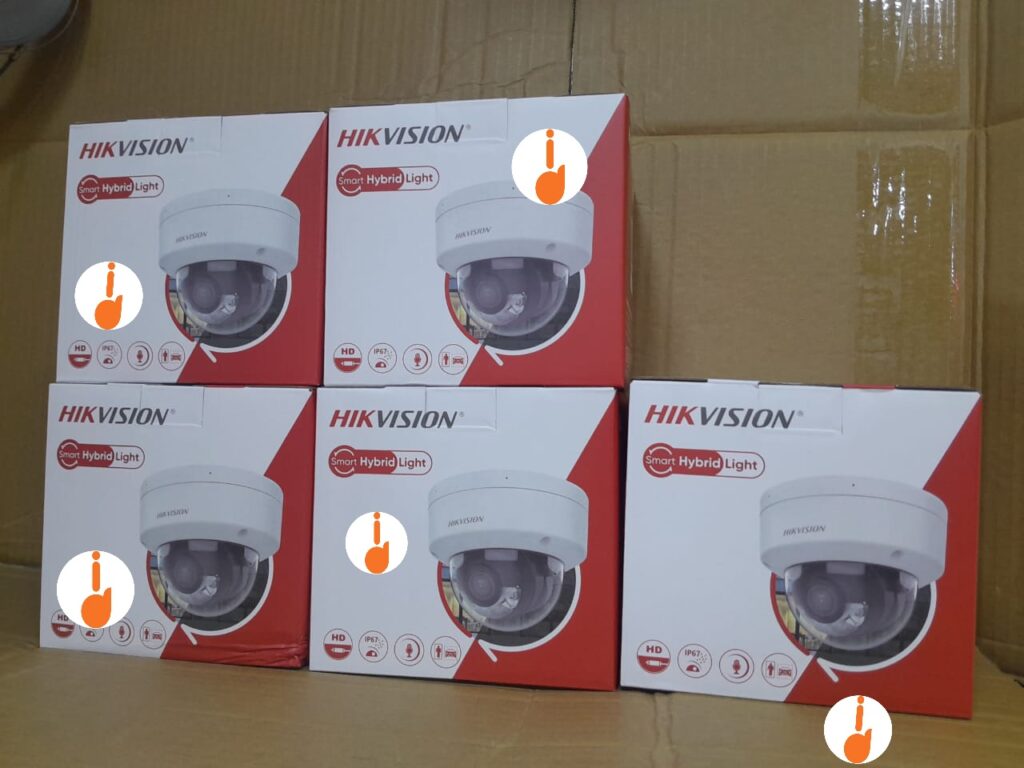
The Hikvision 4MP IP Camera is an excellent choice for Kenyan homes and businesses due to its ability to deliver high-quality surveillance in diverse environments. With its 4MP resolution, it captures clear, detailed footage that is essential for identifying individuals or objects, making it ideal for urban areas and commercial establishments where monitoring critical details like faces and vehicle license plates is crucial. Its smart motion detection features, including human and vehicle targeting, reduce false alarms, ensuring accurate alerts in bustling settings like Nairobi’s busy neighborhoods or Mombasa’s commercial hubs. Additionally, its weatherproof design (IP67-rated) and durable build allow it to withstand Kenya’s varied climate, from the coastal humidity to the dry heat of regions like Turkana.
Get the best prices for the HikVision 4MP Camera in Kenya from our online shop. Alternatively, visit us at our physical store in Nairobi. The store is located on Accra Trade Center, Accra Rd. Find us in the Basement, Shop B1.
How the HikVision 4MP Camera Keeps Your Business Safe
For Kenyan businesses, the camera’s remote access capabilities through the Hik-Connect app provide convenience and peace of mind, allowing owners to monitor their properties from anywhere. This is especially beneficial for SMEs managing multiple locations or families ensuring home safety while traveling. The PoE support simplifies installation, reducing setup costs—a significant advantage for cost-conscious consumers. With flexible storage options, including local SD card and cloud or NVR compatibility, it caters to the unique needs of both individual households and large enterprises. Combining affordability, durability, and cutting-edge technology, the Hikvision 4MP IP Camera is tailored to meet Kenya’s growing demand for reliable, high-performance security solutions.
Why Choose the HikVision 4MP Camera?
When it comes to surveillance, clarity, and reliability are key—and the HikVision 4MP IP Camera delivers both. Known for its exceptional image resolution, advanced motion detection, and robust weatherproof design, this camera is a favorite for businesses and homeowners alike. But is it the right fit for your security needs?
In this post, we’ll break down its standout features, explore where it excels, and help you determine whether this cutting-edge solution aligns with your requirements. Let’s dive in and find out if this is the camera you’ve been looking for!
Key Features:
The HikVision 4MP IP Camera is packed with advanced features that make it a popular choice for surveillance. Here’s a detailed breakdown:
- High-Resolution Video Quality
4 Megapixels (2560×1440): Offers crystal-clear video, providing sharper details than standard 1080p cameras. High resolution cameras make it possible to capture faces, license plates, and other critical details.
- Advanced Night Vision
Infrared (IR) Technology: Ensures visibility even in complete darkness, typically up to 30 meters (varies by model).
Low-Light Performance: Equipped with technologies like DarkFighter for superior clarity in dim conditions. - Smart Motion Detection
Human and Vehicle Targeting: Reduces false alarms by distinguishing between human movement, vehicles, and irrelevant activity like leaves or animals.
Customizable Zones: Allows you to set detection zones to focus on specific areas. - Weatherproof and Durable Design
IP67/IP66 Rated: Resistant to dust and water, making it suitable for outdoor use in harsh conditions.
Temperature Tolerance: Operates reliably in extreme heat or cold. - Wide Dynamic Range (WDR)
Handles challenging lighting conditions, such as bright backlight or shadowy areas, ensuring balanced and clear images. - Remote Access and Control
Mobile App Integration: View live footage and playback recordings via apps like Hik-Connect.
Browser and PC Support: Access the camera from desktops and laptops with intuitive interfaces. - Easy Installation and Integration
Power over Ethernet (PoE): Simplifies installation by requiring only a single cable for both power and data.
Compatible with Hikvision’s NVRs (Network Video Recorders) for seamless system integration. - Storage Options
Onboard SD Card Slot: Supports local storage for easy access to recordings.
Cloud and NVR Storage: Offers flexible options for larger-scale setups or redundant backups. - Advanced Compression Technology – H.265+/H.265 Codec: Reduces bandwidth and storage requirements while maintaining high video quality.
- Intelligent Features (Varies by Model)
Intrusion Detection: Alerts for unauthorized access into predefined areas.
Line Crossing Detection: Monitors movement across virtual lines set by the user.
Face Detection and Analytics: For high-security environments, certain models include face recognition capabilities.
Why Choose Hikvision 4MP IP Camera?
- Balances performance and affordability, making it ideal for both residential and commercial use.
- Offers flexible configurations for indoor and outdoor applications.
This camera is designed to adapt to various security needs while providing dependable performance and excellent image quality. Whether you’re securing a small property or a large business, the Hikvision 4MP IP Camera is a strong contender.
🔹 Fiber Optic Splice Protection Sleeves – Available at Instant Device
At Instant Device, we stock high-quality fiber optic splice protection sleeves designed to safeguard your fiber splicing points. These sleeves provide durability, reliability, and protection for fiber splices, ensuring low signal loss and long-lasting network performance.
✅ Protects spliced fibers from bending, moisture, and breakage
✅ Transparent sleeve for easy inspection
✅ Available in different sizes for various fiber applications
✅ Ideal for FTTH, data centers, and enterprise networks
📍 Visit us on the Basement (Shop B1) – Accra Trade Center, Kenneth Matiba Road (Formerly Accra Road), Nairobi.
📞 Call/Text/WhatsApp: +254114746858 for delivery.
See more photos here.
Fiber Optic Adapters (Couplers) Now Available at Instant Device
Looking for reliable fiber optic adapters to keep your network running seamlessly? At Instant Device, we stock a wide range of LC, SC, APC, and UPC couplers—perfect for connecting and aligning fiber connectors with precision.
✅ High-quality and durable build
✅ Available in single-mode & multi-mode options
✅ Ideal for patch panels, ODFs, and distribution boxes
✅ Ensures low signal loss and stable connectivity
📍 Visit us at: Basement (Shop B1) – Accra Trade Center, Kenneth Matiba Road (Formerly Accra Rd), Nairobi
📞 Call/Text/WhatsApp: +254114746858
💬 Hit the WhatsApp button below for quick assistance.
Upgrade your fiber network today with trusted adapters from Instant Device! 🚀
Fiber BackBone Equipment
Build your fiber optic network today at a discounted price.

